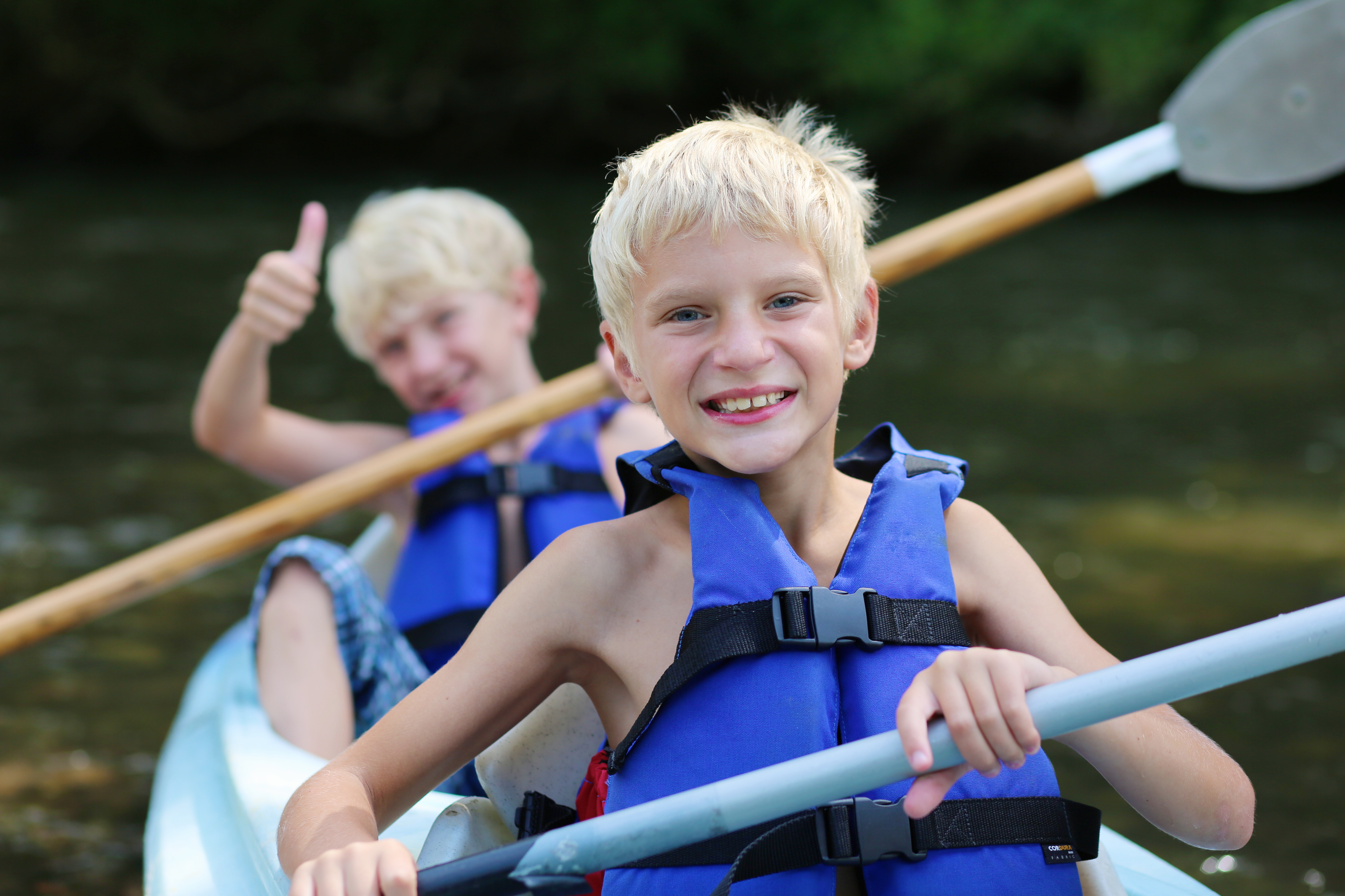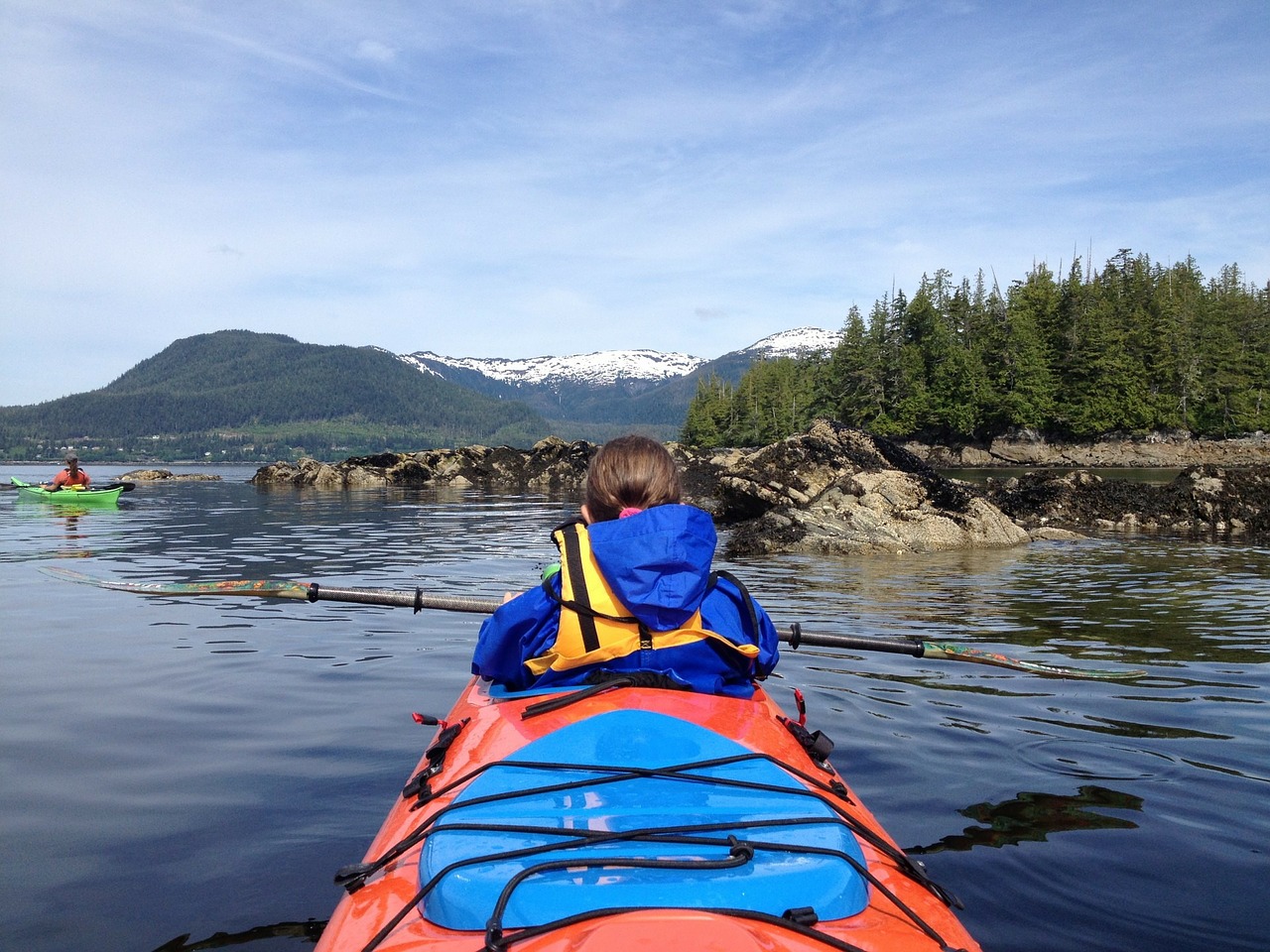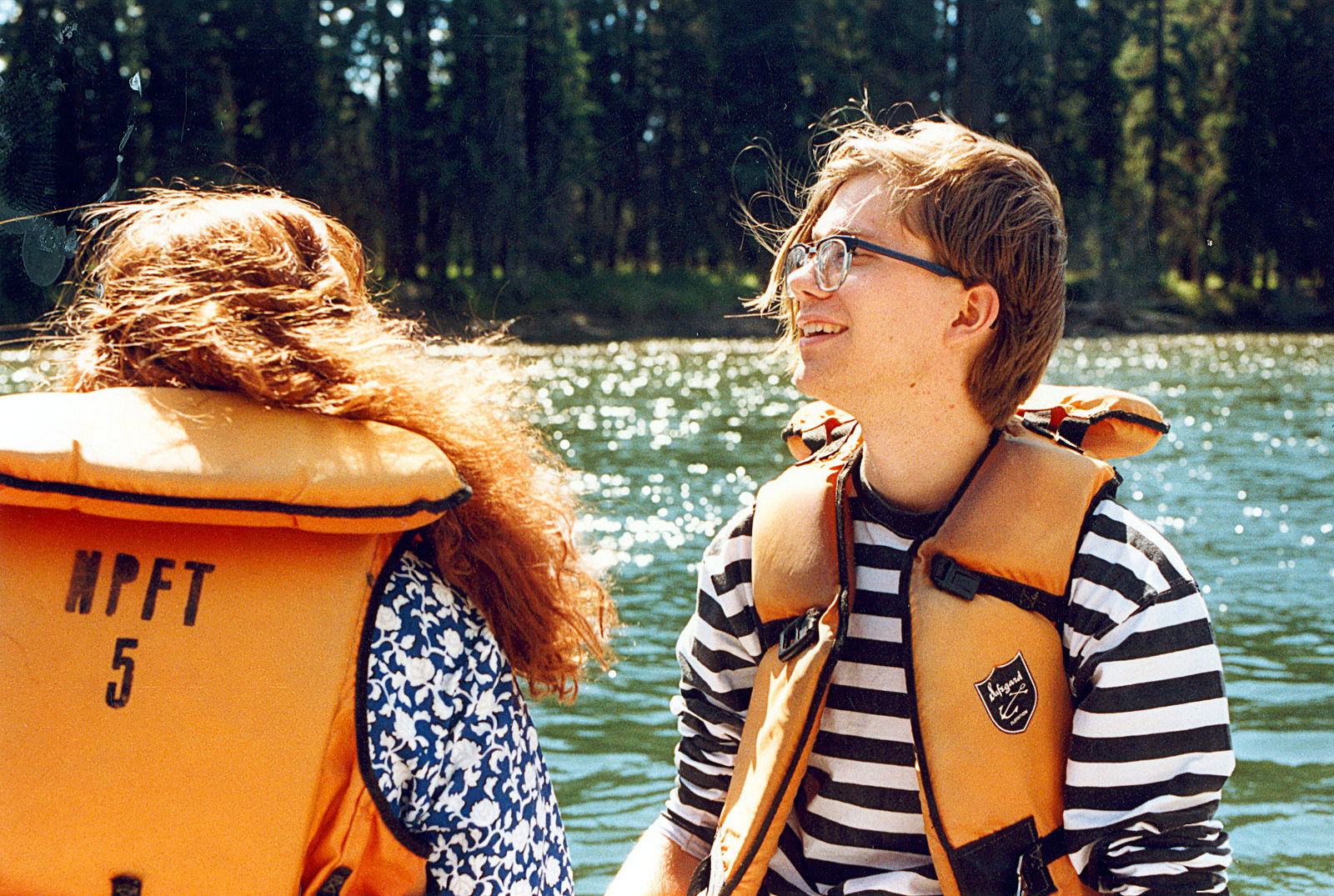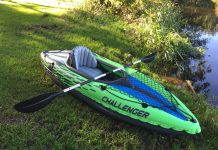
Spending time kayaking on the lake can be a great family activity. However, when you choose to bring children along for the trip, the planning process becomes much more involved.
Follow our guide to make the most of your family trip, while staying safe and having fun.
7 Steps for Safe Kayaking with Kids

1. Get Your Feet Wet
Before heading out for your kayak adventure, be sure that everyone going on the trip is comfortable in the water.
Getting your child accustomed to the water before going on your trip will help keep your entire group safe. It might also cut down on any potential meltdowns and tantrums when you arrive.
If your child isn’t already used to the water, sign them up for swim lessons as soon as possible. Swimming is an important skill for every child, but especially for those who will be spending significant time on the water during family outings.
Local pools, community centers, YMCAs, and colleges often offer swim lessons for children as young as one year old. When you and your child attend the lessons together, you’ll each learn how to be safe in the water, and you’ll gain tips for what to do in case of an emergency.
While you most likely won’t need to use those emergency skills while kayaking, it can provide peace of mind for everyone involved.
You might also be able to find a location that offers kayak lessons for kids, either near your home or at the place where you’ll be getting on the water.
You may have plenty of experience on the water yourself, but teaching kids the ins and outs of kayaking is very different from teaching another adult. An experienced instructor will be able to help your child feel safe and comfortable while making sure that the information and skills taught sink in.
2. Choose Your Kayak
Depending on your child’s age and skill level, they may ride in the same boat as you or paddle their own.
If you already own a kayak, you may need to test that it’s suitable for family kayaking. When you add kids to the mix, you’ll need to consider their comfort and safety, as well as the practicality of the boat.
Before purchasing a new kayak, visit a retailer to test out a variety of sizes and designs. Be sure to get your child involved in the decision making. Early involvement will make them comfortable in the kayak from the beginning while getting them excited about your upcoming trip.
Riding with You
Typically, for children ages seven and under, you’ll want them to ride with you in the cockpit between your legs.
Another option for young children is duffing. Duffing in a kayak means having the child ride in the storage compartment of the boat while you do the paddling. Duffing is an excellent way to get your child used to the water and the feeling of being in the kayak. However, it will slow you down, so plan the length of your trip accordingly.
What About Canoes?
A canoe can be a safer and more comfortable option for young children. Canoes offer plenty of space for spreading out, stashing gear, and accommodating more people.
They’re also fairly stable, which can be helpful with kids who aren’t quite comfortable on the water yet.
Going It Alone
As your child gets a little older, you can have them pitch in with the paddling from the bow of a canoe or double kayak. However, it won’t be long before they want to be captain of their own ship.

Helping out paddling at the bow of a double kayak
As your child builds their skills, move them into a small single kayak, then move up to a medium single kayak.
Transitioning kayaks should be a gradual process based on a child’s ability to handle a larger craft and a step up in paddling difficulty.
Sit-in or Sit-on-top?
Choosing a sit-in or sit-on kayak will depend on what type of water you’ll be in.
In colder water, you’ll want a decked kayak. This will keep you protected from the elements. Note that it’s safer to wait until a child has some experience in a kayak before going into colder water.
In warmer water, sit-on-top kayaks are a great option, especially for children who have a hard time adjusting to the constraints of an enclosed cockpit. Plus, they can burn off extra energy by hopping in and out of the kayak and going for a swim.
An inflatable canoe or inflatable sit-on-top kayak is another good choice for kids as it will feel like floating on a raft.
No matter the type of kayak you choose, remember that kids should always be at the bow of the boat, allowing you to keep them in sight at all times.
What About Kid Sized Paddles?
Don’t forget you’ll need to choose the paddles as well. Look at the options for child sized paddles, which are designed to be shorter and with a narrower shaft to better fit a child’s hands.
3. Safety First
Naturally, including children in an excursion will introduce the need for extra safety precautions.
As we discussed earlier, swimming lessons are a great place to start. Helping your child feel safe and comfortable in the water will eliminate the panic factor if something should go wrong while kayaking.
Make Sure Children Are Fitted for a PFD

(Image Flickr / Bart Everson)
Safety gear is also an important consideration for both adults and children.
By law, each person in a small craft must wear a personal flotation device (PFD). Child sized PFDs are made according to weight.
There are three sizes to choose from:
- Infant for 8-30 lbs
- Child for 30-50 lbs
- Youth for 50-90 lbs
It’s important to choose the correct size to ensure that the device will provide the proper amount of buoyancy to keep your child afloat in the water. Just like the kayak itself, children may need some practice to get used to wearing the PFD.
Let them try it on at home before leaving. When you arrive at your destination, have them spend some time in the water while wearing the PFD to get used to the way it feels to float.
Set Some Ground Rules
Before getting on the water, be very clear about the rules. You want the trip to be a fun experience, but rules are important to ensure that everyone stays safe.
Simple rules, like no standing or leaning, should be repeated frequently. Remind your child that if the rules aren’t followed, you won’t be able to continue kayaking.
Basic Safety Practices
Learning about the actual kayak you’ll be using and practicing safety drills will calm fears and help to prevent dangerous situations on the water.
Make sure that everyone is briefed on basic safety practices. Be sure to practice getting in and out of the kayak, and go over the procedure for executing a wet exit.
There should be a rescue plan in place in the event of a capsize, which will most likely involve holding onto the boat if in deep water.
4. Planning Your Trip
Where will you be going for your kayaking adventure?
The location you choose will determine many of the details of your journey. Here are a few factors you’ll want to think about when planning a trip with kids.
Location, location, location
Location isn’t only important when it comes to real estate. Where you go paddling and the conditions encountered there, will have a major influence on trip enjoyment and safety.
Choosing a location with calm water and minimal currents is wise.
Small, protected lakes are a great place for children (and adults) to learn paddling and get used to the kayak.
Local outdoors groups, online message boards, and staff at outdoors stores can be a great source of information when looking for the ideal destination for your family.
Trip Length
Consider the length of your trip as well. Kayaking requires lots of energy, even more so on days when the sun is beating down.
Remember that kids will run out of steam quickly. This means that you’ll want to plan shorter periods of time on the water, factor in more bathroom breaks and time for snacks, and consider other activities that the family can enjoy while you’re at your destination.
Most beginners, regardless of age, have had enough of paddling within an hour or so of being on the water.
Adult Supervisors
How many experienced, adult paddlers will be on the trip?
If the kids are fairly new to paddling, you ideally want one adult supervising each child. However, as your child’s experience and confidence grows, it will be safe for them to bring a buddy along.
Taking into account a child’s paddling ability, awareness of the water and the hazards present, swimming skills, and combining it with a dose of common sense, will give you a good indication of the amount of supervision required. That being said, always err on the side of caution.
Take Baby Steps
The length of your trips, the time you spend on the water, and the difficulty level of your treks will increase as your child gets older and accumulates more experience. Until then, be conservative with your expectations.
Short day trips at lakes close to home can make for fun family outings, without forcing anyone into committing to a long excursion.
If your trip goes well, great! You can plan a longer trip for your next outing. If things don’t exactly go according to plan, you’ll be glad not to have made a big time investment. Instead, you can head home for the day and try again another time.
5. Do Your Research
While shorter day trips won’t require a great deal of packing and planning, longer trips will. Here are a couple of things you should be thinking about.
Local Attractions
To make the most of your experience, take some time to research your destination before leaving.
Will you be traveling far from home? Get some information about the area you’ll be going to. Pick up a guidebook that describes local wildlife, sightseeing opportunities, and activities close by.
Consider your child’s interests when researching and planning the trip. This will help you to get everyone excited about the trip and prevent boredom and complaining once you get there.
Weather and Area Hazards
In the days leading up to your trip, check out the local weather and water conditions. You’ll want to be prepared for any bad weather that you might encounter, and have a plan in place if you happen to get rained out.
If you’re planning to kayak on a river, know that water conditions can change quickly. Check on the current and boat traffic before going out.
6. Pack Your Bags
As the adult, it should be your responsibility to ensure that you have the clothing, food, safety equipment, and gear you’ll need for your adventure.
If you’ve gone on camping trips before, you probably already have a tried and true packing list for the essentials. If not, here are a couple of things to consider.
Snacks and Drinks
You may have a fully-stocked picnic basket waiting for you on the shore, but it’s always a good idea to pack a snack, even if it’s just to relieve boredom.
You may not expect to get wet, but you should bring foods that won’t disintegrate with a mild splashing. Cereal bars, nuts, and trail mix make good paddling treats.
Also, make sure to bring plenty of drinking water, it’s easy to become dehydrated when paddling on a hot day.
Clothing
Clothing choice should be based on the weather, and the temperature of the water – you never know when you might take a dip.
Light and breathable clothing will protect the skin on sunny days. A hat will shield the top of your head, neck, and ears, and sunscreen will protect any areas left exposed.
On colder days, layers of synthetic material will keep you warm and won’t retain as much water if they get wet. Dressing in light layers makes it easier to account for a variety of weather conditions. Packing a fold-away anorak or a poncho will prepare you for torrential conditions.
Comfortable but protective shoes should be worn. Sandals may work in some areas, but running shoes or diving booties offer better protection in the water.
Bringing along an extra change of clothes will keep your child comfortable if you get caught in the rain or end up in the water at any point.
Entertainment
Bringing along a few extras can help kids have fun on and off the water. Bring a pair of binoculars to check out the local wildlife. A notebook and pencil are great for taking notes about what you see and do while you’re away from home. Books and a deck of cards can help keep boredom at bay.
The key to packing for a trip with kids is to include a few extras to help everyone stay dry, comfortable, and happy.
Get younger kids involved by allowing them to help choose their clothing and a favorite toy to take along.
Older kids will probably want some more freedom when packing. Give them a packing list to follow, and be sure to double check their bag before leaving to avoid accidentally leaving anything important behind.
7. Hit the Water!
Before you launch, take some time to go over the rules one last time.
Review the procedure for getting out of the boat, and what to do in case of an emergency. Answer any questions your child might have before you leave the land. And most importantly, don’t forget to take one last bathroom break right before getting in the kayak.
While you’re in the water, take the time to explain everything to your child. Point out the actions you’re taking and the techniques you’re using as they come up. Ask your child if they have any questions.
Take it slow while everyone gets comfortable. If your child is helping with paddling, it’s important to be patient. Let them take the lead and take breaks whenever they need it. Remember that they’re still learning and getting used to the motions.
Things won’t always go according to plan. The weather might not cooperate all day, a child might get bored, or exhaustion might set in earlier than you expected.
If you’re patient and willing to go with the flow, you can readjust plans and keep everyone in good spirits by changing things up with a game or a snack break.
Kayaking should be a fun experience for the whole family. When everyone has a good time, you’ll all leave with a positive experience and can get excited about your next adventure.
As an Amazon Associate, we earn from qualifying purchases. This is without any additional costs for the buyer but does support us in maintaining our website.




One lesson I learned this year with my 12 year old son. I have a hobie Proangler 14 a large and stable kayak and he has an 11.5 sit on top fishing basic fishing kayak. While he has been paddling on his own in warmer weather/water months and does very well and has not ever flipped. He accompanied me on a late windy spring fishing trip in a shallow backwater area of our lake in middle Michigan. While the temperature was in the high 70’s the water was still a little cool for swimming. He started to move to a new location and flipped over. Not sure why I saw it happen. He just flipped. We were prepared with securing all his gear and having his PFD on. His kept his composure and did not panic but none the less he was a little shaken and afraid. I immediately came to his recue and tried to tow both him and his overturned loaded kayak back to shore. Securing ropes after the fact was challenging and I wanted to get him out of water before a chill set in. So we left his kayak and I pulled him to shore. I retrieved his kayak and all was fine. While he was in shallow water this time and could have walked to shore I realized that if he flipped in the future in deeper water that timing is critical. Our lakes have heavy boat traffic it can get pretty choppy and this could happen again. Since then I have been keeping him tethered with about 25 feet of rope tied from the back of my kayak to the front of his kayak. This gives us both a greater feeling of security, keeps him close by during windy outings because our kayaks drift at very different speeds. It has also helped me teach him both kayaking and fishing skills because we can communicate easier and when he has problems I can quickly pull him along side. I have a large carabineer affixed to the end of the rope that attaches to his kayak to allow him to detach and free paddle as he pleases. However I like him tethered when it is windy or there is a lot of motor boat traffic so we don’t get separated. I use this technique with my 17 year old daughter not so much for the safety but helping with fishing that she has only lately been interested. This approach has really maximized our family enjoyment as well enhanced safety. The rope tether and quick release carabineer give them flexibility to paddle on there own and keeps safely them close at hand crossing deep open water. I recommend this approach since smaller kayaks on the market better suited to kids from a paddling standpoint often don’t have wide enough beam for stability.
Thanks very much for your storey, Eric. It really highlights the need to be extra vigilant when you’re paddling with kids – even when they’re experienced paddlers and have never flipped before.
I like your tip. It’s simple but highly effective, and gives everyone piece of mind. Thanks for sharing!